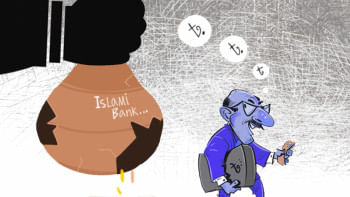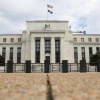Should US bank failures concern Bangladesh’s financial sector?

In a village, there used to be a rich man who used to drink wine every night. Eventually, he died of liver damage. A poor man in the same village used to hate the rich man for his drunkardly behaviour. However, the poor man was a chainsmoker and he, too, died one day of lung cancer. On the surface, their deaths are not correlated, and their terminal diseases are different. But the core cause is the same: addiction.
What has led to bank failures in the US may look different from what Bangladeshi banks are living through now, but the bottom line is the same. The failure to understand the term mismatch between assets and liabilities, and inept risk management – which led to the collapse of two US banks – are quite common in most Bangladeshi banks (with a slightly different texture).
The Silicon Valley Bank (SVB) was founded in 1983. It focused on the clientele of technology start-ups and venture capital. Being situated in the heart of the world's leading tech village in Santa Clara, California, the bank became very popular among young tech entrepreneurs, particularly in the 1990s. The Covid pandemic forced remote workers to make the best use of technology and the internet. And that acted as a springboard for the bank, whose deposits rose steeply to $175 billion in 2022, from a low of $62 billion in 2020. SVB invested that money into the most secure treasury bonds and mortgage-backed securities.
SVB's decision couldn't have been a better one at the time because of the pandemic-led recession, when the stock market was in a pathetic state.
But sticking to that stance even in 2022-2023 triggered the sudden death of SVB, because it failed to update its strategy from what it was in 2022 when the US' central bank took on a new tightening stance – just diametrically opposite to its position in 2020-2021. With rising inflation, which the US hadn't seen in 40 years, the Fed kept on raising its policy rate from early 2022 – which made the return on government bonds much more attractive than before. But SVB was sitting on a mountain of previously-purchased bonds, which were supposed to earn near-zero interest rates. And, hence, they were less attractive to secondary market buyers.
Unlike stocks, bonds have a different trajectory. Bondholders wait till the maturity date to redeem the full face value of their instruments, while stocks have no maturity timelines. As such, SVB's managers were waiting on the maturity dates rather than selling them on secondary markets at losses. This was akin to holding onto a deposit pension scheme, waiting for its maturity date, rather than breaking it before its maturity and thus incurring losses.
But luck didn't favour the SVB due to increased pressure on deposit withdrawals, stimulated by rising inflation and the ensuing increased demand for cash. SVB was compelled to sell off some public securities at losses, hurting their income statement.
Bangladesh's financial policymakers are quick to brush aside any risk the country's financial sector may be facing. Some may even go as far as to claim Bangladesh's financial stability as being much superior to that of the US'. But their claims are fundamentally flawed if they downplay what has happened in the US.
On March 8, the SVB disclosed its loss of around $2 billion, sparking a fire of fears among tech depositors who are apt at communicating messages within a couple of minutes. The bank's entire tech clientele rushed frantically to withdraw their deposits at lightning speed. Within 24 hours, $42 billion evaporated from the bank's vault, triggering a classical bank run and forcing the collapse of the 40-years-old financial institution.
The ghost of the Great Depression reappeared under a different facade.
The SVB wasn't supposed to fall for reasons which lead other banks to die. It was a sound bank with no fears of default loans or insidious plundering by its directors – which also means most Bangladeshi private banks are fragile. The SVB's asset position was quite good at $209 billion against its liability of deposits to the tune of $175 billion. The nature of the asset side was also secure because of the US treasury bonds and mortgage-backed securities. But the management failed to address the term mismatch between deposits and investments.
Deposits being susceptible to fluctuating withdrawal patterns is a situation belonging to the short run, while investment securities being locked under maturity contracts falls under the long run. Still, the tenure mismatch would have been manageable to some extent if customers didn't keep on withdrawing cash at a more-than-anticipated rate due to growing consumption demand and a stubborn inflation during 2022-2023.
The Signature Bank of New York, whose main clientele was law firms, collapsed due to a different set of reasons. It was already known to be a distressed bank due to its past obsession with crypto currency. When the bubble of crypto burst in 2022, Signature Bank's asset base deflated, too. Still, the bank was more or less surviving. But the panic that originated from the SVB also erupted among the depositors of Signature, triggering a premature death that resembles the same bank run of the 1930s. The ripple effect hit Credit Suisse in Europe, too, though Credit Suisse has been long known for troubles and scandals.
Bangladesh's financial policymakers are quick to brush aside any risk the country's financial sector may be facing. Some may even go as far as to claim Bangladesh's financial stability as being much superior to that of the US'. But their claims are fundamentally flawed if they downplay what has happened in the US. Herein lies the relevance of the story of how the poor man died despite not drinking wine every night like the rich man. The state of asset-liability mismatch and the risk of a liquidity crisis are quite prevalent among all Bangladeshi banks.
The governor of Bangladesh's central bank recently blamed the periodical mismatch in the banking sector as a major cause of rising defaults. Though the major cause is political indulgence and policy slackness for the big defaulters as well as fund launderers, the governor is quite right in pointing out a flaw in the banking sector that has been prevalent for decades. Short-term deposits can best be used for working capital, not for long-term funding of investments (which should be collected from the stock market).
The US government stood beside the SVB, and the rescue effort was justified since the bank was not a house of defaulters and fund looters. The SVB has helped technology to boom and has created thousands of jobs. Its assets weren't toxic. President Biden warned that the wrongdoers in the bank's management will be brought to justice. If Bangladeshi policymakers can't bring local wrongdoers to justice, that would be the biggest concern for the country's financial industry.
Dr Birupaksha Paul is a professor of economics at the State University of New York at Cortland in the US, and former chief economist at Bangladesh Bank.

 For all latest news, follow The Daily Star's Google News channel.
For all latest news, follow The Daily Star's Google News channel. 










Comments